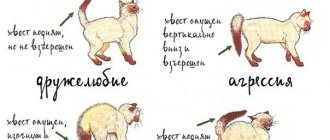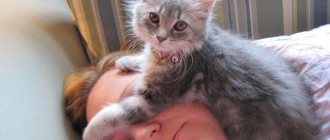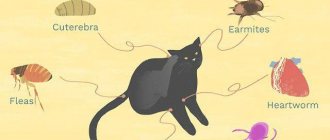Every cat has a different personality, some are more outgoing than others, but when a typically sociable cat suddenly becomes quiet and withdrawn, it can be cause for concern.
Most of the time, cat owners don't understand why their cat is sad or upset. But by looking out for some signs, you can rest easy knowing that this could be temporary. Also, learn more about some common causes of depression in cats and the best ways to deal with it.
Experts identify 10 main signs of depression:
- apathy, refusal to eat, even treats and activity;
- increased irritability, desire to hide, to be alone;
- sudden mood changes;
- refusal to care for your fur;
- damage to furniture and other items;
- plaintive, causeless meows;
- refusal to go to the toilet in your litter box;
- attempts to mark territory in sterilized cats;
- change in behavior: an affectionate cat suddenly becomes angry and aggressive.
Often, owners do not notice the first signs of depression in their pet. In addition, disturbances in the psycho-emotional state can be caused by hormonal changes or problems in the functioning of internal organs. Therefore, first you need to contact your veterinarian.
Expanding our horizons
Another way to add variety to your cat's space is to choose toys that stimulate different senses. For example, many cats are of great interest in the olfactory mat, in the secluded corners of which she will look for a treat. Also, various balls or cups, where access to food opens after solving the puzzle, will cheer up a bored cat.
Cats may also enjoy the ball maze and massagers.
It is necessary to remember that a cat is like a small child - it will quickly get tired of the same toy. But this does not mean that you need to constantly buy new ones. It is enough to hide some of the toys from the cat and once every ten days replace those that the pet has already become accustomed to.
How to help get out of depression?
The owner needs to devote more time to the animal and try to distract it by any means. You can force him to hunt and try to encourage him to take action, including play. If the cat does not want to be active, you should not press on it. It is better to treat her with treats, be nearby, stroke her and talk affectionately.
Cats are very fond of elevations and various houses. They can be purchased at a pet store or made yourself. You also need to give your pet more space to run around, for example, chasing a laser pointer. Don’t forget about having a scratching post in the house - scratching surfaces is the norm for these animals, reports the Ivethelp website.
Cats are mysterious animals. Even the owner is not always able to determine what mood his pet is in. Despite this, experts from the British Veterinary Association explained that a cat’s emotions can be determined quite accurately by its tail.
Why else can a cat be sad?
If the animal is healthy, but behaves unusually quietly, perhaps something has changed in the environment, and this is alarming it. Perhaps the cat is afraid of someone or something. Maybe there is a new tenant in the house, a person or an animal? Did the newcomer offend your furry pet?
Or maybe the cat was offended by the owner? Yes, this happens too. Cats, although independent animals, are completely bored without company. She can be angry with her owner for several days if he leaves her alone for a long time.
In any case, if the cat is sad, it is worth giving her a little more affection and attention to her cat problems.
We are sad: Our cat seems to be sad
Agree, how one sight of a sad, saddened cat can hurt its loving owner. We sometimes go to all sorts of tricks just to amuse our pet. But we should not forget that not all cats can constantly enjoy life like clowns; after all, each cat is an independent person. And yet, we will try to understand the reasons for your cat’s sadness, if any.
Scientists have found that cats react heavily to changes in their usual environment around them. They will definitely mourn their deceased owner and will worry when he simply goes on a business trip or vacation. The divorce of spouses and the departure of one of them will also be a stressful situation for the cat. When we deeply experience something ourselves, all our feelings also fall heavily on the “shoulders” of our furry pets.
The reasons for bad mood in cats can be different.
Illness or injury. Depression can be a companion to a disease such as hypothyroidism. Once thyroxine levels return to normal, depression will quickly disappear.
What signs should alert you?
Voice prompts - unhappy cats often descend into a low, mournful howl. And in fact: in quiet cats, the howl becomes louder, while in restless cats, on the contrary, it becomes quiet and dull.
Purring is not always a sign of happiness. Sometimes cats purr to console themselves.
Animal body clues. The eyes, ears, and certain body positions of the cat can indicate some deviations in the animal’s condition. Sad cats tend to be more active and become fearful. A sad cat tries to protect himself from all adversity by sitting on his paws, wrapping his tail around himself and pressing his ears. Sometimes the presence of sadness in a pet can be revealed by a sadly drooping, sort of drooping mustache.
The Ultimate Guide to Cat Care – Are Cats Sad?
yes, in short! Saskies are highly emotional creatures that can cause stress or depression. Sovereignty, hissing, and running are the most common signs of horror. However, you may not always display all the signs of stress.
What do cats do when they are sad?
Cats are known for being super independent and are often mistakenly thought of as lazy... They are anything but lazy! Cats can be sad or happy, but they don't express their feelings in the same way. They may cry when they are lonely, but they usually just sleep it off.
Introduction: What is the connection between cats and depression?
There is a strong correlation between cats and depression. Some people feel a deep connection with their cats, which can lead to feelings of depression.
This is because people tend to identify with an animal more than any other non-living creature.
Many people find companionship in their cat that they cannot find anywhere else. This can help people during periods of loneliness or isolation, especially if the person has no other friends or family members to talk to about their feelings.
The reason for this connection lies in the idea of anthropomorphism, which is described as “the attribution of human qualities, emotions, and motivations to non-human beings.”
Why are cats so depressed?
The relationship between cats and people is complex. Many people love cats, but they are abandoned, abused, or neglected at an alarming rate. This leads to high levels of depression in cats, which can even lead to self-harm and suicide.
It is estimated that up to 50% of cats will experience some form of feline depression.
This happens for many reasons, including mental disorders, physical pain, loneliness or lack of attention.
Some of the most common causes are social isolation, physical abuse, lack of human interaction, and natural disasters.
SEE: Can cats eat yogurt? Top 5 Reasons not to feed your cat yogurt
The more people become aware of this issue, the better they understand and help those who suffer from feline depression.
Feline depressive disorders
There are many types of depressive disorders, but there is a common theme. All of them are characterized by a lack of positive emotions and a need for more activity.
Depression in cats can be very difficult to detect because their body language is difficult to distinguish from normal moods.
The most common symptoms in cats are difficulty going outside to use the litter box, hiding in the closet, not eating, and sleeping more than usual.
(Picture: Getty)
Did you know that cats can get a little sad? Yes, they can, and there are a few signs you should look for to know your kitty is in a bad mood. Cat Protection behavior manager Nicky Trevworth says you should always notice a sad cat. Niki says that if your cat is no longer interested in birds or watching them from the window of the room, or sleeps more than usual, she is sad. She also says that when a cat becomes more withdrawn or hides more than usual, it's a bad sign. It is also the case that the cat becomes less tolerant of people, does not want to jump on laps, furniture or windowsills, or avoids its litter tray. These are bad signs. If your cat is no longer playing, eating or drinking, or has started overeating, your cat may be depressed. And finally, if the cat seems more anxious. They are not sleeping properly, are pacing or acting restless, or if their fur looks unkempt or matted, it is obvious that your cat needs help.
(Picture: Getty)
However, don't worry. There are several things you can do to get your cat to stop frowning and become happy and playful again. Nicki notes, “Find out what’s causing you stress. Take your cat to the vet first to rule out medical causes, since many of the signs of stressed or sad cats are the same signs for cats with medical problems, such as pain. If the veterinarian feels that the underlying cause is behavioral, then contact a qualified animal behavior expert. “Provide your cat with all the resources available around the house. Cats don't like to share, so one resource per cat plus one more in reserve will be enough for you! “Give your cat places to hide and be high up so they feel safe. Cardboard boxes are a fantastic activity for cats. Cats in boxes are like children playing with houses. Nicky advises building a "cat castle" in your home that can't be invaded.
(Picture: Getty)
Nicky continues: “Cats don’t really need friends, so if your cat is sad, it’s not recommended to bring another cat or kitten. “As creatures of habit, cats thrive in routine and predictability. "A pheromone diffuser like Feliway can help the home feel more familiar and calming to the cat." Think of ways to feed your cat to make the food more fun and attractive. For example, you can use a cardboard egg crate to place your cat in, or make a toy that she has to play with to get to the treat.
Nicky added that it's important that you play with your cat - but also give her quiet time when she needs it. She adds: “Give them multiple beds so they can change their sleeping place, just like their wild ancestors did. “Separate the food bowl from the water bowl as they don't like to eat and drink in the same place.
Does a cat understand our emotions?
Anastasia Manko
When it comes to animals that care about how we feel, the first thing that comes to mind, of course, is dogs. But cats, on the contrary, are not so known for their ability to support us in difficult times. There is an opinion that, due to their independence and a certain detachment, they cope worse than dogs with the role of a faithful companion and ally.
But still, can cats feel our emotions?
As a rule, the answer to this question can be confidently “yes.” They can read certain facial expressions, such as happiness or anger. Cats acquire this skill over time. The longer they interact with a person, the more they associate a happy facial expression with pleasant things and actions, and a sad or angry one with less positive ones.
In one experiment, it was even noticed that cats spend more time next to a happy and contented person. Of course, this behavior only works with the owner. It is believed that understanding the emotions of strangers is no longer so easy for cats.
Do cats understand when we are sad?
Of course, such a response to our negative emotions as from dogs has not been observed in cats.
Most likely, they look at us from a more selfish point of view: “What does this facial expression mean to ME?” Accordingly, happy people are associated with actions such as scratching behind the ear or giving a treat, while sad people are associated with less attention to them.
photo:cuteness.com
So, yes, cats do understand our emotions to a certain extent, but they rarely take a personal interest in them unless it is rewarding.
How do they experience emotions themselves?
Mechanisms for the formation of emotions are developed in all animals. The only difference between their emotions and ours is that they do not reach such depth and variety and are mainly used for survival: when hunting, danger and caring for offspring or sick and old relatives.
Based on the findings of scientists from all over the world, cats are unlikely to experience such deep emotions as shame, love, irritation and many others. But, like us, they really can experience sadness and joy.
Source











